Steve+Kang
-
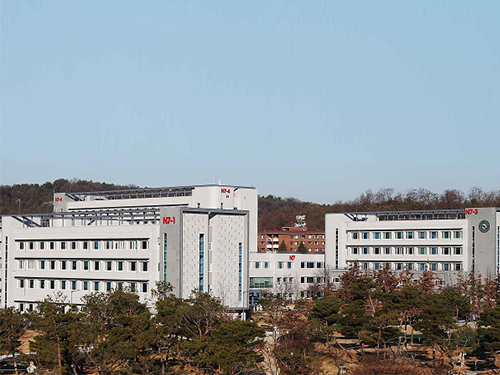 Mechanical Engineering Building on Campus Refurbished
KAIST’s Mechanical Engineering Department has finished the project to remodel its buildings and hosted an opening ceremony on December 12, 2016, which was attended by the university’s senior management and guests including President Steve Kang and Choong-Hwan Ahn, Architecture Policy Officer at the Ministry of Land, Infrastructure and Transport of Korea (MLIT).
With an investment of approximately USD 10 million, the old buildings (each consisting of seven floors and one basement) were transformed into smart, green buildings. Among the upgrades were the establishment of LED lighting systems, the replacement of the exterior walls with insulated materials, and the installation of double-glazed windows, all resulting in the improvement of the buildings’ energy efficiency. Previously, offices and lecture halls in the buildings had individual cooling and heating systems, which consumed a great deal of energy, but they were replaced with a centralized smart energy control system that monitors the operation status as well as energy consumption in real time.
With these new improvements, the Department was able to slash its energy consumption by 32%, for which it received Green Building Conversion Certification from MLIT. The ministry issues the certification to buildings that reduce their energy consumption by over 20% as a result of infrastructure upgrades. Beginning with the Mechanical Engineering buildings, KAIST will work on obtaining this certification for all of its buildings that are either under renovation or construction.
President Kang said, “We are pleased to offer our students a comfortable environment for study and research and will continue improving outdated facilities and infrastructure to make the campus safer and nicer.”
Picture 1: Ribbon-cutting ceremony for the refurbished Mechanical Engineering buildings on campus
Picture 2: Mechanical engineering buildings
2016.12.09 View 8334
Mechanical Engineering Building on Campus Refurbished
KAIST’s Mechanical Engineering Department has finished the project to remodel its buildings and hosted an opening ceremony on December 12, 2016, which was attended by the university’s senior management and guests including President Steve Kang and Choong-Hwan Ahn, Architecture Policy Officer at the Ministry of Land, Infrastructure and Transport of Korea (MLIT).
With an investment of approximately USD 10 million, the old buildings (each consisting of seven floors and one basement) were transformed into smart, green buildings. Among the upgrades were the establishment of LED lighting systems, the replacement of the exterior walls with insulated materials, and the installation of double-glazed windows, all resulting in the improvement of the buildings’ energy efficiency. Previously, offices and lecture halls in the buildings had individual cooling and heating systems, which consumed a great deal of energy, but they were replaced with a centralized smart energy control system that monitors the operation status as well as energy consumption in real time.
With these new improvements, the Department was able to slash its energy consumption by 32%, for which it received Green Building Conversion Certification from MLIT. The ministry issues the certification to buildings that reduce their energy consumption by over 20% as a result of infrastructure upgrades. Beginning with the Mechanical Engineering buildings, KAIST will work on obtaining this certification for all of its buildings that are either under renovation or construction.
President Kang said, “We are pleased to offer our students a comfortable environment for study and research and will continue improving outdated facilities and infrastructure to make the campus safer and nicer.”
Picture 1: Ribbon-cutting ceremony for the refurbished Mechanical Engineering buildings on campus
Picture 2: Mechanical engineering buildings
2016.12.09 View 8334 -
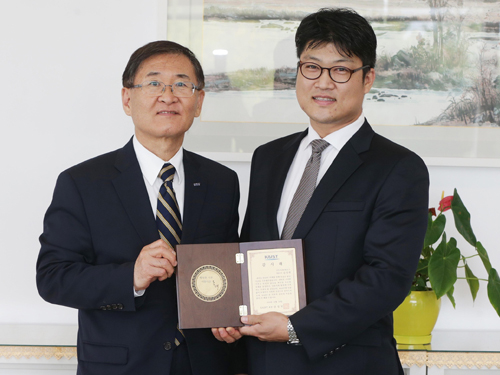 Epapyrus Donates KAIST Paperless Software
Epapyrus, a solution company for e-documents that was created by a KAIST graduate, donated USD 106,000 worth of paperless software to KAIST on October 20, 2015.
President Steve Kang of KAIST presented a plaque of appreciation to President Jung-Hee Kim of Epapyrus to recognize his donation.
To the Class of 2003 in computer science, President Kim said,
“KAIST has always been supportive of me. Even when I neglected my study to focus on the start-up of my company during college, the university encouraged me to pursue my dream. I was thrilled when I learned that KAIST was looking for an e-paper solution package because I knew I could return what I had received to my alma mater.”
President Kang replied,
“President Kim is indeed one of our proud alumni. He created a company based on an innovative idea, and we are pleased to see his company grow steadily. Certainly, we would not have accomplished all the great things without the generous support of our strong alumni.”
In the picture, President Steve Kang of KAIST (left) holds the appreciation plaque together with President Jung-Hee Kim of Epapyrus.
2015.10.23 View 3904
Epapyrus Donates KAIST Paperless Software
Epapyrus, a solution company for e-documents that was created by a KAIST graduate, donated USD 106,000 worth of paperless software to KAIST on October 20, 2015.
President Steve Kang of KAIST presented a plaque of appreciation to President Jung-Hee Kim of Epapyrus to recognize his donation.
To the Class of 2003 in computer science, President Kim said,
“KAIST has always been supportive of me. Even when I neglected my study to focus on the start-up of my company during college, the university encouraged me to pursue my dream. I was thrilled when I learned that KAIST was looking for an e-paper solution package because I knew I could return what I had received to my alma mater.”
President Kang replied,
“President Kim is indeed one of our proud alumni. He created a company based on an innovative idea, and we are pleased to see his company grow steadily. Certainly, we would not have accomplished all the great things without the generous support of our strong alumni.”
In the picture, President Steve Kang of KAIST (left) holds the appreciation plaque together with President Jung-Hee Kim of Epapyrus.
2015.10.23 View 3904 -
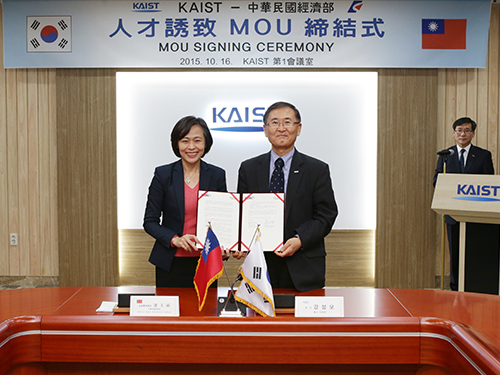 KAIST Agrees to Personnel Exchange with the Ministry of Economic Affairs of the Republic of China
A delegation from the Ministry of Economic Affairs (MOEA) of the Republic of China (ROC) visited KAIST on October 16, 2015.
President Steve Kang of KAIST and Director General Yu-Ping Lien of the Department of Investment Services, MOEA, signed a memorandum of understanding (MOU) on exchanging personnel, recruiting and attracting top talents, and sharing job information.
With the MOU, KAIST and MOEA will develop a mobility program for students in Korea and ROC to help them seek employment opportunities in both nations. Director General Lien hoped that the MOU would bring more of KAIST students in the information technology field to work in ROC.
President Kang responded,
“KAIST has fostered highly talented engineers and researchers across all fields of science and engineering. If these students can have a place in ROC to realize their potential, this certainly could benefit the two nations.”
In the picture from left to right is Director General Yu-Ping Lien of the Department of Investment Services, the Ministry of Economic Affairs of the Republic of China and President Steve Kang of KAIST.
2015.10.17 View 6157
KAIST Agrees to Personnel Exchange with the Ministry of Economic Affairs of the Republic of China
A delegation from the Ministry of Economic Affairs (MOEA) of the Republic of China (ROC) visited KAIST on October 16, 2015.
President Steve Kang of KAIST and Director General Yu-Ping Lien of the Department of Investment Services, MOEA, signed a memorandum of understanding (MOU) on exchanging personnel, recruiting and attracting top talents, and sharing job information.
With the MOU, KAIST and MOEA will develop a mobility program for students in Korea and ROC to help them seek employment opportunities in both nations. Director General Lien hoped that the MOU would bring more of KAIST students in the information technology field to work in ROC.
President Kang responded,
“KAIST has fostered highly talented engineers and researchers across all fields of science and engineering. If these students can have a place in ROC to realize their potential, this certainly could benefit the two nations.”
In the picture from left to right is Director General Yu-Ping Lien of the Department of Investment Services, the Ministry of Economic Affairs of the Republic of China and President Steve Kang of KAIST.
2015.10.17 View 6157 -
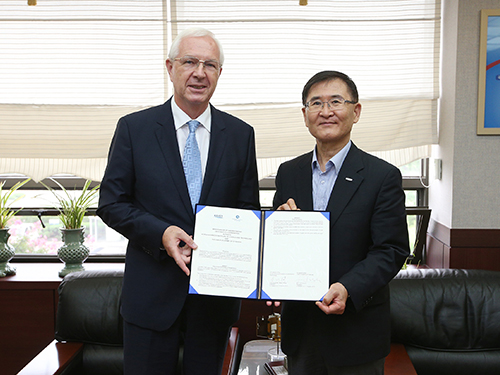 KAIST and the Czech Academy of Sciences Agree to Cooperate
KAIST and the Czech Academy of Sciences (CAS) signed a memorandum of understanding in the office of KAIST’s president on August 11, 2015. Ten people from the two institutions, including President Steve Kang of KAIST and Chairman Jiří Drahoš of CAS participated in the signing ceremony.
Under the agreement, the two institutions will cooperate on establishing joint research programs, sharing up-to-date research outcomes, and medium-and long-term exchange of researchers.
Having more than 50 public laboratories all over the Czech Republic, the Czech Academy of Sciences is the largest research institution in the country. Its research body along with the staff has eight thousand members. The institution focuses on mathematics, physics, biotechnology, and social sciences while running its own Ph.D. program.
President Kang said, “I hope this signing will expand our cooperation with universities and research institutions in Eastern Europe.”
2015.08.18 View 4993
KAIST and the Czech Academy of Sciences Agree to Cooperate
KAIST and the Czech Academy of Sciences (CAS) signed a memorandum of understanding in the office of KAIST’s president on August 11, 2015. Ten people from the two institutions, including President Steve Kang of KAIST and Chairman Jiří Drahoš of CAS participated in the signing ceremony.
Under the agreement, the two institutions will cooperate on establishing joint research programs, sharing up-to-date research outcomes, and medium-and long-term exchange of researchers.
Having more than 50 public laboratories all over the Czech Republic, the Czech Academy of Sciences is the largest research institution in the country. Its research body along with the staff has eight thousand members. The institution focuses on mathematics, physics, biotechnology, and social sciences while running its own Ph.D. program.
President Kang said, “I hope this signing will expand our cooperation with universities and research institutions in Eastern Europe.”
2015.08.18 View 4993 -
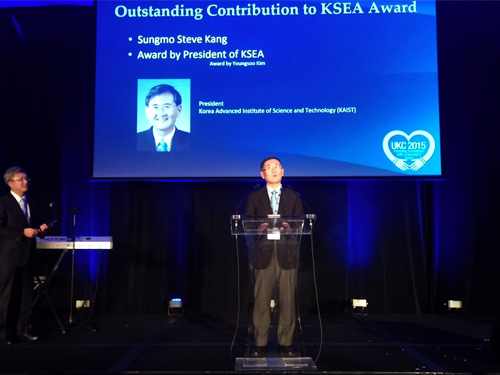 President Steve Kang of KAIST Receives the Outstanding Contribution Award from the Korean-American Scientists and Engineers Association
The Korean-American Scientists and Engineers Association (KSEA), a non-profit Korean professional organization based in the United States with over 6,000 registered members, bestowed upon President Steve Kang of KAIST the 2015 Outstanding Contribution Award.
The award is presented to a person who has made significant contributions to the development of KSEA.
The award ceremony took place during the 2015 US-Korea Conference on Science, Technology, and Entrepreneurship (UKC), which was held on July 30, 2015, at the Hyatt Regency Hotel in Atlanta, Georgia.
The UKC is the flagship conference of KSEA, which takes place every year, and covers science, engineering, technology, industry, entrepreneurship, and leadership. It attracts more than 1,200 participants from the US and Korea. The UKC 2015 was held on July 29-August 1, 2015.
President Kang has participated in UKC conferences over the past few years as a plenary speaker, addressing major issues in science and technology for both nations, and provided generous support for the activities of UKC and KSEA. He also promoted discussions and exchanges of professional knowledge in his field, microelectronics, by organizing fora and symposia.
He addressed the UKC 2015 as a plenary speaker with a speech entitled “Pursuing Excellence with a Servant’s Heart.” President Kang said that good leadership should bring out synergistic contributions from all constituents and achieve excellence under all circumstances. He mentioned one example of good leadership, known as humble leadership, and explained how such leadership played an important role in the development of scientific breakthroughs, such as the world’s premier high-end microprocessor chip sets first produced by his team under extremely high pressure.
2015.08.05 View 8810
President Steve Kang of KAIST Receives the Outstanding Contribution Award from the Korean-American Scientists and Engineers Association
The Korean-American Scientists and Engineers Association (KSEA), a non-profit Korean professional organization based in the United States with over 6,000 registered members, bestowed upon President Steve Kang of KAIST the 2015 Outstanding Contribution Award.
The award is presented to a person who has made significant contributions to the development of KSEA.
The award ceremony took place during the 2015 US-Korea Conference on Science, Technology, and Entrepreneurship (UKC), which was held on July 30, 2015, at the Hyatt Regency Hotel in Atlanta, Georgia.
The UKC is the flagship conference of KSEA, which takes place every year, and covers science, engineering, technology, industry, entrepreneurship, and leadership. It attracts more than 1,200 participants from the US and Korea. The UKC 2015 was held on July 29-August 1, 2015.
President Kang has participated in UKC conferences over the past few years as a plenary speaker, addressing major issues in science and technology for both nations, and provided generous support for the activities of UKC and KSEA. He also promoted discussions and exchanges of professional knowledge in his field, microelectronics, by organizing fora and symposia.
He addressed the UKC 2015 as a plenary speaker with a speech entitled “Pursuing Excellence with a Servant’s Heart.” President Kang said that good leadership should bring out synergistic contributions from all constituents and achieve excellence under all circumstances. He mentioned one example of good leadership, known as humble leadership, and explained how such leadership played an important role in the development of scientific breakthroughs, such as the world’s premier high-end microprocessor chip sets first produced by his team under extremely high pressure.
2015.08.05 View 8810 -
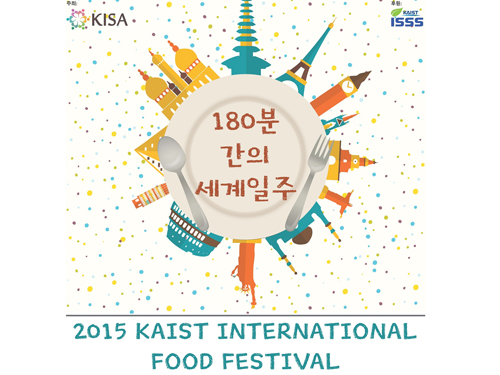 KAIST International Food Festival
The KAIST International Students Association (KISA) hosted the 2015 International Food Festival in front of Creative Learning Building, KAIST, on May 22, 2015.
This was the 11th International Food Festival for KAIST where international students introduced food from their home countries to strengthen cultural exchanges with Korean students. This year’s festival was the biggest international festival in Daejeon in which around 500 students and staff from KAIST, Chungnam National University (CNU), the University of Science & Technology (UST), and the public participated.
KAIST’s President Steve Kang opened the festival with a welcoming speech, followed by congratulatory speeches by CNU President Sang-Chul Jung and UST President Un-Woo Lee.
The first section of the event was the food festival where around 40 kinds of food from ten countries including Kenya, Kazakhstan, India, and Turkey were presented. Students from each country offered cooking demonstrations in booths, and participants purchased the food.
Cheryl Wanderi, a Kenyan student who recently received a Master’s degree from KAIST’s Department of Bio and Brain Engineering last February said, “I am delighted to introduce Mandazi, a Kenyan donut, to not only Korean students but also other international students.”
The second half of the event consisted of cultural performances from different countries. There were eight teams performing including an Indonesian traditional Saman dance team, a Kazakh group that performed on traditional instruments, and an Azerbaijani K-POP dance team.
Sung-Hyon Myaeng, the Associate Vice President of KAIST’s International Office, said, “Despite their busy lives, students from three different universities planned this event to get to know each other. I hope international students and Korean students can come together and enjoy the festival.”
Edrick Kwek, the President of KISA, said, “This food festival is an event showing the cultural diversity of KAIST in the most splendid way.”
2015.05.27 View 11036
KAIST International Food Festival
The KAIST International Students Association (KISA) hosted the 2015 International Food Festival in front of Creative Learning Building, KAIST, on May 22, 2015.
This was the 11th International Food Festival for KAIST where international students introduced food from their home countries to strengthen cultural exchanges with Korean students. This year’s festival was the biggest international festival in Daejeon in which around 500 students and staff from KAIST, Chungnam National University (CNU), the University of Science & Technology (UST), and the public participated.
KAIST’s President Steve Kang opened the festival with a welcoming speech, followed by congratulatory speeches by CNU President Sang-Chul Jung and UST President Un-Woo Lee.
The first section of the event was the food festival where around 40 kinds of food from ten countries including Kenya, Kazakhstan, India, and Turkey were presented. Students from each country offered cooking demonstrations in booths, and participants purchased the food.
Cheryl Wanderi, a Kenyan student who recently received a Master’s degree from KAIST’s Department of Bio and Brain Engineering last February said, “I am delighted to introduce Mandazi, a Kenyan donut, to not only Korean students but also other international students.”
The second half of the event consisted of cultural performances from different countries. There were eight teams performing including an Indonesian traditional Saman dance team, a Kazakh group that performed on traditional instruments, and an Azerbaijani K-POP dance team.
Sung-Hyon Myaeng, the Associate Vice President of KAIST’s International Office, said, “Despite their busy lives, students from three different universities planned this event to get to know each other. I hope international students and Korean students can come together and enjoy the festival.”
Edrick Kwek, the President of KISA, said, “This food festival is an event showing the cultural diversity of KAIST in the most splendid way.”
2015.05.27 View 11036 -
 The Hancom and KAIST Research Center Opens
KAIST and Hancom, Inc., an office suite developer in Korea, established a joint research center to develop software technology and its related industry. President Steve Kang of KAIST, Sang-Chul Kim, the Chief Executive Officer (CEO) of Hancom, and professors from the computer science department at KAIST attended a ceremony to celebrate the opening of the center.
KAIST and Hancom signed a memorandum of understanding in April this year for the development of software industry in Korea, and based on the agreement, the two institutions identified five research projects and created a research center to implement them effectively.
President Kang said, “I hope that the research center will serve as a good example of university and industry collaboration. To that end, we will provide our support to the maximum extent possible to lead the software industry in Korea. We are also planning to hold a joint workshop on the latest trends in software technology and on the education of software developers.”
Established in 1990, Hancom created the native word processor for the Korean language called “Hangul.”
2014.11.05 View 8881
The Hancom and KAIST Research Center Opens
KAIST and Hancom, Inc., an office suite developer in Korea, established a joint research center to develop software technology and its related industry. President Steve Kang of KAIST, Sang-Chul Kim, the Chief Executive Officer (CEO) of Hancom, and professors from the computer science department at KAIST attended a ceremony to celebrate the opening of the center.
KAIST and Hancom signed a memorandum of understanding in April this year for the development of software industry in Korea, and based on the agreement, the two institutions identified five research projects and created a research center to implement them effectively.
President Kang said, “I hope that the research center will serve as a good example of university and industry collaboration. To that end, we will provide our support to the maximum extent possible to lead the software industry in Korea. We are also planning to hold a joint workshop on the latest trends in software technology and on the education of software developers.”
Established in 1990, Hancom created the native word processor for the Korean language called “Hangul.”
2014.11.05 View 8881 -
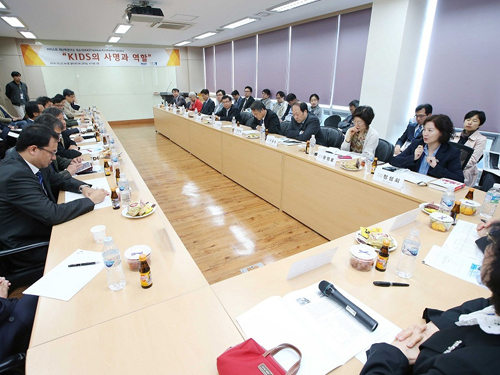 The KAIST Institute for Disaster Studies (KIDS) Opens
About 60 professors from across different departments at KAIST teamed up to make Korean society safer and more secure.
The professors voluntarily created the KAIST Institute for Disaster Studies (KIDS) that will implement the following responsibilities:
- Conduct research on disaster prevention and reduction
- Develop policy on safety and preventive measures for the public
- Establish resilience engineering programs at the university
- Create a platform for social media and machine-based information management
- Develop robot-based search and rescue mission programs
- Conduct disaster risk assessments and develop disaster-recovery plans
- Establish virtual reality programs for training and education
An opening ceremony for the institute took place on campus on October 22, 2014. President Steve Kang of KAIST, Young Jin, a National Assemblyman of the Republic of Korea, Myung-Ja Kim, a former Minister of the Environment of the Republic of Korea, Professor Hee-Kyung Park of the Department of Civil and Environmental Engineering at KAIST, and other dignitaries attended the ceremony.
Professor Park, the Director of KIDS, said, “In recent years, our society has seen many tragic accidents that claimed hundreds of lives. This prompted us to examine the fundamental cause of accidents and forced us to review our current public safety policies and measures. As a result, we were able to identify many reasons, among others, technological problems in public facilities and structures, lack of social policies and systems to protect public safety, and human error.”
He further explained the need for KIDS as follows:
“In order to understand the cause of disasters and prepare remedies, such as how disasters happen, how to respond to them, and what to do for recovery, we need to have a comprehensive approach to the issues from the various perspective of social policy, science, and engineering. KIDS has been created to meet these needs.”
Following the opening ceremony, a seminar was held on the topic of “KIDS’s Mission and Its Role.”
2014.10.24 View 7953
The KAIST Institute for Disaster Studies (KIDS) Opens
About 60 professors from across different departments at KAIST teamed up to make Korean society safer and more secure.
The professors voluntarily created the KAIST Institute for Disaster Studies (KIDS) that will implement the following responsibilities:
- Conduct research on disaster prevention and reduction
- Develop policy on safety and preventive measures for the public
- Establish resilience engineering programs at the university
- Create a platform for social media and machine-based information management
- Develop robot-based search and rescue mission programs
- Conduct disaster risk assessments and develop disaster-recovery plans
- Establish virtual reality programs for training and education
An opening ceremony for the institute took place on campus on October 22, 2014. President Steve Kang of KAIST, Young Jin, a National Assemblyman of the Republic of Korea, Myung-Ja Kim, a former Minister of the Environment of the Republic of Korea, Professor Hee-Kyung Park of the Department of Civil and Environmental Engineering at KAIST, and other dignitaries attended the ceremony.
Professor Park, the Director of KIDS, said, “In recent years, our society has seen many tragic accidents that claimed hundreds of lives. This prompted us to examine the fundamental cause of accidents and forced us to review our current public safety policies and measures. As a result, we were able to identify many reasons, among others, technological problems in public facilities and structures, lack of social policies and systems to protect public safety, and human error.”
He further explained the need for KIDS as follows:
“In order to understand the cause of disasters and prepare remedies, such as how disasters happen, how to respond to them, and what to do for recovery, we need to have a comprehensive approach to the issues from the various perspective of social policy, science, and engineering. KIDS has been created to meet these needs.”
Following the opening ceremony, a seminar was held on the topic of “KIDS’s Mission and Its Role.”
2014.10.24 View 7953 -
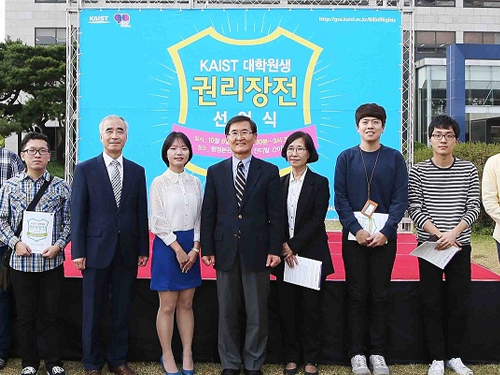 KAIST Introduces a Student Bill of Rights
The Graduate Student Association at KAIST (GSA) established a Bill of Rights for students, outlining student basic beliefs, rights, and obligations. This was the first time for Korean university students to create their own Bill of Rights.
The Bill consists of a total of 21 articles. The preamble of the Bill states individual rights for students, confirming that the Constitution of the Republic of Korea extends to the members of the KAIST community. The Articles stipulate the rights and obligations of students, covering such rights as healthcare, marriage, maternal care, privacy protection, study and research opportunities, and security.
The GSA held a ceremony to inform KAIST members of the Bill of Rights in front of the Main Administration building on October 6, 2014. Approximately 100 students and faculty members, including President Steve Kang, joined the ceremony. They expressed support for students’ efforts to build a better environment conducive to study and research.
Yeon-Ju Kim, the GSA President, said, “The Student Bill of Rights will serve as the first step to raise awareness about our rights and obligations. The Student Association will continue making efforts to provide KAIST students with an opportunity to study and live in a happier and healthier environment.”
2014.10.11 View 6907
KAIST Introduces a Student Bill of Rights
The Graduate Student Association at KAIST (GSA) established a Bill of Rights for students, outlining student basic beliefs, rights, and obligations. This was the first time for Korean university students to create their own Bill of Rights.
The Bill consists of a total of 21 articles. The preamble of the Bill states individual rights for students, confirming that the Constitution of the Republic of Korea extends to the members of the KAIST community. The Articles stipulate the rights and obligations of students, covering such rights as healthcare, marriage, maternal care, privacy protection, study and research opportunities, and security.
The GSA held a ceremony to inform KAIST members of the Bill of Rights in front of the Main Administration building on October 6, 2014. Approximately 100 students and faculty members, including President Steve Kang, joined the ceremony. They expressed support for students’ efforts to build a better environment conducive to study and research.
Yeon-Ju Kim, the GSA President, said, “The Student Bill of Rights will serve as the first step to raise awareness about our rights and obligations. The Student Association will continue making efforts to provide KAIST students with an opportunity to study and live in a happier and healthier environment.”
2014.10.11 View 6907